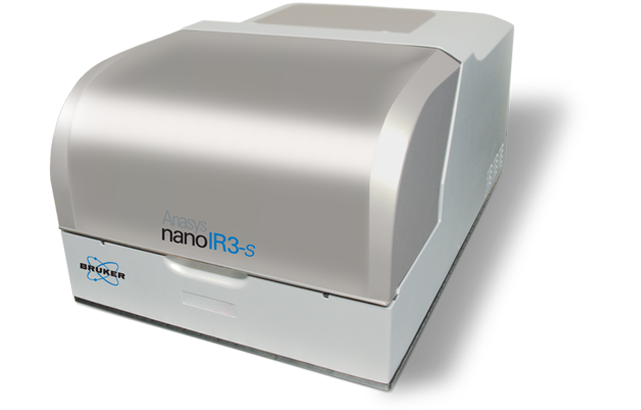Anasys nanoIR3-s
브루커의 Anasys nanoIR3-s 시스템은 주사광학현미경(s-SNOM)과 나노스케일 IR 분광법(AFM-IR)을 통합 원자력 현미경(AFM)과 결합하며, 이 모든 것을 단일 플랫폼에서 지원합니다. AFM 기반 나노 광학 특성화에서 Anasys의 우수한 기술을 이용해 nanoIR3-s는 2D 물질 샘플측정에서 입증된 10나노미터 이하의 공간 해상도를 가지고 나노스케일 IR 분광법, 화학적 이미징 그리고 광학 특성 매핑을 제공합니다. 또한 이 시스템은 나노미터 크기의 해상도로 AFM 표면 이미징 및 재료 특성 이미지를 가능하게 하여 광범위한 재료 과학 응용 분야에서 관련 연구를 위한 이상적인 장비입니다.
To learn more, continue reading, contact us, or see FAQs about this product.
10nm의 공간 해상도의 화학 이미지 및 분광법
그래핀 플라즈모닉스
고해상도 특성 이미지화
고성능 Nano FTIR 분광법
오직 nanoIR3-s에서 제공하는 기능은 다음과 같습니다.
- 고성능의 nano FTIR 분광법
- 최첨단 NanoIR 레이저 광원을 지원하는 고성능의 IR SNOM 분광법
- DFG laser를 이용한 nano FTIR 분광법, 연속체 기반 레이저 광원 광대역 싱크로트론 광원 통합
- 분광법 및 화학 이미지용 멀티칩 QCL 레이저 광원
POINTspectra 기술
POINTspectra 레이저는 광범위한 파장에 걸친 분광법과 고해상도 광학 특성 이미지화를 모두 지원합니다. nanoIR3-s를 사용하면 상관 관계 데이터를 생성하는 간단한 작업이 가능합니다.
- AFM 이미지에서 측정할 특성을 선택합니다.
- 시료의 분광법을 측정하고, 관심 있는 파장을 선택합니다.
- 고해상도 광학 특성 이미지화를 생성합니다.
Broadband Laser Option
Nanoscale FTIR spectroscopy with the broadest available spectral range (670 to 4000 cm⁻¹)
Equipped with optional OPO/DFG femtosecond laser technology, the nanoIR3-s system delivers the broadest spectral range to enable high-performance combined spectroscopy and high-resolution nanochemical imaging. This unique set of capabilities enables research in a broad range of research areas in historically inaccessible spectral regions.
Complementary high-resolution imaging
High-quality, high-resolution nano-optical images can be generated for characterization of a wide range of optical phenomena, such as graphene plamonics and surface phonon polaritons in hexagonal boron nitride (hBN), and chemical imaging of biological and other organic samples.
Frequently Asked Questions
Yes, nanoIR3-s combines AFM-IR with s-SNOM capabilities for advanced studies of plasmonic, photonic, and electronic materials. Offering multimodal nanospectral analysis.
nanoIR3-s offers Tapping AFM-IR and Resonance Enhanced AFM-IR as standard, and can be equipped with Surface Sensitive AFM-IR if the appropriate lasers and probes are included in the configuration.
External-source coupling is possible but should be discussed with Bruker to ensure compatibility.
More About Bruker's Nanoscale Infrared Technology
Yes. Bruker’s photothermal AFM-IR technology produces spectra that are directly comparable to FTIR spectra, as demonstrated in published documentation and peer-reviewed articles. AFM-IR spectra can be searched directly against FTIR spectral databases. If FTIR-like spectral analysis is critical for your application, our experts can provide evidence showing spectral correlation.
Photothermal AFM-IR provides direct absorption-based spectra that closely match FTIR results and are easier to interpret than Raman-AFM or s-SNOM. Further, Photothermal AFM-IR signals are amplified by the resonant enhancement of the cantilever providing the best signal-to-noise of those techniques. Bruker offers s-SNOM as a separate option for advanced near-field studies.
Bruker nanoIR systems routinely achieve chemical imaging with spatial resolution below 10 nm and can detect single molecular layers. Actual performance depends on your sample and selected measurement mode.
Yes, photothermal AFM-IR can chemically map and identify particles smaller than one micron, including nanoplastics and environmental contaminants. Direct correlation to FTIR provides ready interpretation in particles as small as 10 nm.
Bruker’s photothermal AFM-IR systems typically require a single socket of standard electrical power,and CDA. Specific requirements may vary by model, so request a site preparation guide from your Bruker representative.
Bruker photothermal AFM-IR systems primarily use quantum cascade lasers (QCLs) that deliver stable, reliable performance and broad coverage across the mid-infrared fingerprint region as well as optical parametric oscillators (OPOs) for the C-H, O-H, N-H stretching region. Multiple QCL chips can be combined to access all key spectral windows required for routine and advanced research, and additional sources are available for specialized applications. Bruker’s application experts can help you select the optimal laser configuration to match your measurement needs and ensure sufficient spectral resolution for both standard and demanding experiments.
Measurement times vary by application, but point spectra can be acquired in seconds, chemical maps in minutes, and automated recipes can be tailored for high-throughput workflows.
Routine maintenance includes probe replacement, laser alignment checks, and calibration with reference samples. Bruker provides detailed maintenance protocols and support plans.
